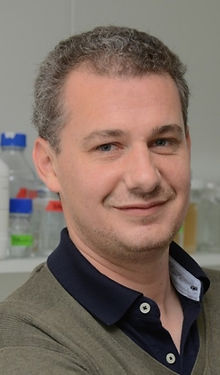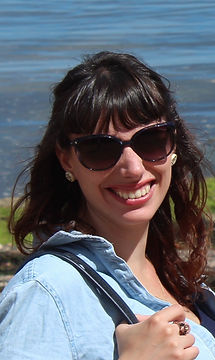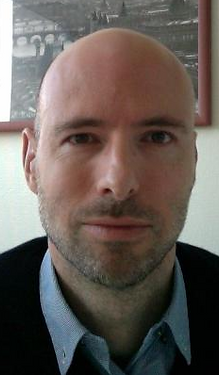
Club Noyau
discussion group on nuclear dynamics, nuclear architecture and genome integrity & expression
session 2022
ANNOUNCEMENT
CHANGES!!! We are changing the location of the meeting to the Institut Pasteur. From now on we will need you to register in the below link (free) before attending.
NEXT MEETING
JULY 6th
IN PERSON MEETING!
AT PASTEUR INSTITUTE
The Speakers
Upcoming Speakers

Olivier Gavet
UMR9019 « Genome Integrity and Cancers », CNRS - Gustave Roussy.
The team of Olivier Gavet uses specific FRET-based kinase activity sensors to monitor the dynamics of kinase activity throughout the mitotic cell cycle and its response to stress situations. They have recently developed a Chk1 sensor that allowed its activity characterization. Chk1 shows a basal activity during unperturbed growth sustained throughout S phase and relying on replication origin firing. Incremental Replication Stress (RS) triggers stepwise Chk1 over-activation that delays S-phase, suggesting a rheostat-like role for DRC coupled with the replication machinery. Upon RS, Chk1 is inactivated as DNA replication terminates but surprisingly is reactivated in a subset of G2 cells, which rely on Cdk1/2 and Plk1 and prevents mitotic entry. Cells can override active Chk1 signaling and reach mitosis onset, revealing checkpoint adaptation. Cell division following Chk1 reactivation in G2 results in a p53/p21-dependent G1 arrest, eliminating the daughter cells from proliferation.

Maxime Wery
UMR3244 « ARN non codant, épigénetique et fluidité du génome », Institut Curie.
Long non-coding (lnc)RNAs are now recognized as important regulators involved in multiple cellular processes. Surprisingly, despite they were initially presumed to be devoid of coding potential, recent works have revealed that lncRNAs can be translated. LncRNA-derived micropeptides can have actual intra/extra-cellular roles or be the source of neoantigens driving the immune response, but they might also represent proteins “in progress” throughout evolutionary constraints. However, despite the interest they arouse, the cis- and trans-acting mechanisms controlling the synthesis of these peptides remain poorly characterized. We propose that translation of lncRNAs could expose lncRNA-derived micropeptides to the natural selection, reflecting the ongoing evolutionary process of de novo gene birth, while Nonsense Mediated mRNA Decay (NMD) would prevent the accumulation of the transcript they originate from.
Past Speakers - Session 6
01
Epigenetics

Sophie Polo
UMR7216 « Epigenetics and Cell Fate », Université de Paris - CNRS.
Our research program aims at deciphering the coordinated maintenance of genome and epigenome stability in response to genotoxic stress. We use mammalian cellular models to investigate the fundamental mechanisms that contribute to epigenome integrity at different levels of chromatin organization, from histone and DNA modifications up to higher-order chromatin domains, following DNA damage. We combine cutting-edge imaging, proteomics and epigenomics technologies for a comprehensive characterization of chromatin landscapes during the repair response. Reciprocally, we analyze the impact of epigenome alterations on genome stability by focusing on histone mutations in pediatric cancers.
04
Mitotic exit

Manuel Mendoza
Institut de Génétique et de Biologie Moléculaire et Cellulaire (IGBMC). Strasbourg, France.
Our lab studies fundamental mechanisms of nuclear division and organisation. For instance, we characterised the NoCut abscission checkpoint, a signalling pathway that coordinates cytokinesis with the completion of chromosome segregation to maintain genomic stability. More recently, we discovered a novel mechanism to regulate gene positioning and expression, based on differences in nuclear pore complex acetylation in yeast mother and daughter cells.
03
Telomere Dynamics

Teresa Teixeira
Institut de Biologie Physico-Chimique (IBPC). Paris, France.
Telomeres ensure the integrity of the genome. During replicative senescence telomeric sequences progressively shorten and fix the limit of cell proliferation. Loss of the telomere length homeostasis is the common feature to all cancer cells and abnormally short telomeres are the origin of a spectrum of fatal degenerative syndromes such as pulmonary fibrosis and bone marrow failures.
The genomic instability related to senescence is the origin of important genomic and phenotypic variants, perhaps even of the senescence escape characteristic of cancer. The goal of our work is thus to study the generation, the extent, and the consequences of this genomic instability. To do this, we use the yeast Saccharomyces cerevisiae, a simplified model for the study of very heterogeneous phenomena and in which we have developed unique tools to overcome and even explore the heterogeneity related to telomeres and replicative senescence.
Past Speakers - Session 5
01
Telomere Dynamics

Stéphane Coulon
Centre de Recherche en Cancerologie de Marseille (CRCM). Marseille, France.
Stéphane Coulon is a senior researcher, leading his projects within Vincent Geli's Lab in the CRCM. Variations in telomere status are critical for cell senescence, stem cell biology, and the development of cancer.
The team investigates in budding and fission yeast how telomeres are replicated and maintained and the cellular responses to telomere erosion. Their work recently explored the role of the Nuclear Pore Complex in processing eroded telomeres and collapsed replication forks and the mechanisms of telomere maintenance during quiescence using fission yeast as model.
02
Transcription

Mounia Lagha
Institut de Génétique Moléculaire de Montpellier (IGMM). Montpellier, France
The lab of Mounia Lagha studies the mechanisms of transcriptional regulation in living Drosophila embryos using a variety of approaches ranging from classical genetics, molecular biology to quantitative live imaging and biophysical techniques.
Past speakers - Session 4
01
Gene expression

Andreas Mayer
Max Planck Institute for Molecular Genetics
Berlin (Germany).
We study the key mechanisms that underlie the regulation of chromatin-mediated transcription by RNA polymerase II in differentiated mammalian cells and during cell differentiation. Specifically, we aim to understand how post-initiation regulatory events are established in a dynamic chromatin environment in vivo and how these regulatory mechanisms control and coordinate cellular differentiation
02
Cell biology

Alfonso Fernández Álvarez
Center for Developmental Biology of Andalusia
Seville (Spain).
Centrosomes are the major microtubule center in the cell and are responsible for spindle nucleation, the vehicle for chromosome segregation during cell division. In certain cases, the spindles self-assemble in the absence of centrosomes; for example, this situation occurs frequently in female meiosis. In our lab, we have generated a system using fission yeast to understand the molecular basis behind spindle self-assembly that will help shed light on acentrosomal meiosis, a crucial event for understanding gametogenesis.
Past Speekers - Session 3
01
Gene expression

Mathieu Rougemaille
Institut de Biologie Integrative de la Cellule (I2BC)
CNRS - Gif-sur-Yvette
Our team works on the post-transcriptional mechanisms involved in the control of sexual differentiation in the fission yeast Schizosaccharomyces pombe. Specifically, we focus our research on the role of RNA-binding proteins and long non-coding RNAs in shaping gene expression profiles during the mitosis to meiosis transition. We use a combination of genetic and biochemical tools as well as genomic and protein/RNA imaging techniques.
02
Chromatin dynamics

Karine Dubrana
Institut de Biologie François Jacob
CEA - Fontenay aux Roses
Our research focuses on the role of nuclear organization and chromatin dynamics in the maintenance of genome stability. In particular, we aim at defining how nuclear organization and chromatin status (euchromatin versus heterochromatin) influences the detection, processing and subsequent repair of DNA lesions.
Past Speekers - Session 2
01

Pierre Therizols
Gebi Team - UMR Inserm 944. CNRS 7212
Hôpital Saint-Louis
Our research focuses on studying the functional role of the reorganisation of heterochromatin during early development. We use a combination of microscopy and epigenome editing technologies to investigate the contribution of the histone variant H3.3 and its chaperone Daxx in pericentromeric spatial organization of ground-state embryonic stem cells.
Epigenetics
Maxim Greenberg
Chromatin dynamics in mammalian development
Institut Jacques Monod
" We strive to gain a clear understanding of the profound epigenetic consequences of DNA methylation in a window of development, which occurs in the first week of mouse embryogenesis, and the second of human, but the repercussions of which can ripple throughout life."

02
Chromatin Dynamics
Past Speakers - Session 1
01

Epigenetics
Camille Lobry
Laboratoire de Hématopoïèse normale et pathologique
Gustave Roussy - Inserm / Université Paris Saclay
My research focuses on the role of non-coding genome in the development of blood cancers and most particularly Acute Myeloid Leukemia. I use combination of epigenetics, genomic and screening technologies based on high throughput sequencing to interrogate enhancer dysregulation and long non-coding RNA function in leukemia.
Charlène Boumendil
Laboratoire "Fonctions non-conventionnelles des pores nucléaires"
Institut Jacques Monod - Équipe V. Doye
My research focuses on the role of nuclear pores in chromatin organization and gene expression during senescence.

02
Chromatin organization
03
Genome Integrity

Thèrese Wilhelm
Laboratoire Genome Instability and Stability (SInG)
Institut Cochin / Inserm
Our laboratory is interested in the subtle balances of between the different mechanisms that orchestrate DNA repair, protecting against genetic instability while allowing genetic diversity (antibodies, gametes, molecular evolution).
Stéphane Marcand
Laboratoire Telomeres and Repair of Chromosomes
CEA / Inserm
Dicentric chromosomes are abnormal structures that can be important contributors to pathological states. The general aim of our lab is to dissect the pathways preventing dicentrics formation and decipher how dicentric are broken upon mitotic exit and cytokinesis.

04
Chromosome segregation
Agenda
July 6th
14:30
Olivier Gavet - "Limitations of the DNA replication checkpoint upon replication stress and consequences on cell outcome"
15:15
Maxime Wery - "Translation as an unexpected player in the metabolism of long non-coding RNAs"
16:00
Talks and discussion will be followed by social time with some wine and cheese.
Session 5
Talk1
Stéphane Coulon - "Replication dynamics of telomeric sequences in fission yeast. (C)ST complex: a master piece for DNA end replication"
Talk2
Mounia Lagha - " Transcriptional dynamics and memory during zygotic genome activation "
Talk3
Germano Cecere - " Small RNAs in epigenetic inheritance "
Talk4
Teresa Teixeira - " Telomeres and the control of cell proliferation "
Past events
Session 6
Talk1
Manuel Mendoza - " Control of mRNA Export and Cell Cycle Commitment by Nuclear Pore Complex Acetylation "
Talk2
Sophie Polo - " Epigenome maintenance in response to DNA damage "
Session 4
Talk1
Andreas Mayer - "Mechanisms of genome transcription regulation"
Talk2
Alfonso Fdez Alvarez -"Spindle self-assembly in fission yeast meiosis"
Session 3
Talk1
Mathieu Rougemaille - "A scaffold lncRNA shapes mitosis to meiosis switch"
Talk2
Karine Dubrana - "The heterochromatin protein Sir3 interacts with Sae2 to regulate its function at DNA double strand breaks"
Session 2
Talk1
Pierre Therizols - "Daxx safeguards pericentromere integrity in embryonic stem cells"
Talk2
Maxim Greenberg - "Early Embryonic Events, Life-Long Epigenetic Memory"
Session 1
Talk1
Camille Lobry - "CRISPRi screening of clustered regulatory elements reveal functional cooperating dependencies in cancer"
Talk2
Charlène Boumendil - "Chromatin organization and gene expression in senescence: from the global to the fine scale"
Talk3
Therese Wilhelm - “Centriole splitting and increased Microtubule Stability under Replication Stress cause Numerical Chromosomal Instability”
Talk4
Stéphane Marcand - "A Telomere Protection Pathway Targeting the Rad50 Complex"

Institut Jacques Monod
Bâtiment Buffon, 15 rue Hélène Brion, 75205 Paris CEDEX 13 - France
L'Institut Jacques Monod (IJM), unité mixte de recherche du CNRS et de l'université Paris Diderot, est l'un des principaux pôles de recherche fondamentale en biologie de la région parisienne.
Session 4
Talk1
Andreas Mayer - "Mechanisms of genome transcription regulation"
Talk2
Alfonso Fdez Alvarez -"Spindle self-assembly in fission yeast meiosis"
Session 3
Talk1
Mathieu Rougemaille - "A scaffold lncRNA shapes mitosis to meiosis switch"
Talk2
Karine Dubrana - "The heterochromatin protein Sir3 interacts with Sae2 to regulate its function at DNA double strand breaks"
Session 2
Talk1
Pierre Therizols - "Daxx safeguards pericentromere integrity in embryonic stem cells"
Talk2
Maxim Greenberg - "Early Embryonic Events, Life-Long Epigenetic Memory"
Session 1
Talk1
Camille Lobry - "CRISPRi screening of clustered regulatory elements reveal functional cooperating dependencies in cancer"
Talk2
Charlène Boumendil - "Chromatin organization and gene expression in senescence: from the global to the fine scale"
Talk3
Therese Wilhelm - “Centriole splitting and increased Microtubule Stability under Replication Stress cause Numerical Chromosomal Instability”
Talk4
Stéphane Marcand - "A Telomere Protection Pathway Targeting the Rad50 Complex"
Session 4
Talk1
Andreas Mayer - "Mechanisms of genome transcription regulation"
Talk2
Alfonso Fdez Alvarez -"Spindle self-assembly in fission yeast meiosis"
Session 3
Talk1
Mathieu Rougemaille - "A scaffold lncRNA shapes mitosis to meiosis switch"
Talk2
Karine Dubrana - "The heterochromatin protein Sir3 interacts with Sae2 to regulate its function at DNA double strand breaks"
Session 2
Talk1
Pierre Therizols - "Daxx safeguards pericentromere integrity in embryonic stem cells"
Talk2
Maxim Greenberg - "Early Embryonic Events, Life-Long Epigenetic Memory"
Session 1
Talk1
Camille Lobry - "CRISPRi screening of clustered regulatory elements reveal functional cooperating dependencies in cancer"
Talk2
Charlène Boumendil - "Chromatin organization and gene expression in senescence: from the global to the fine scale"
Talk3
Therese Wilhelm - “Centriole splitting and increased Microtubule Stability under Replication Stress cause Numerical Chromosomal Instability”
Talk4
Stéphane Marcand - "A Telomere Protection Pathway Targeting the Rad50 Complex"

